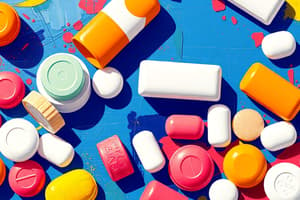Podcast
Questions and Answers
What is the term for when medications enter the body and travel from the administration site into the body's circulation?
What is the term for when medications enter the body and travel from the administration site into the body's circulation?
- Bioavailability
- Affinity
- Distribution
- Absorption (correct)
What is the term for an unintended pharmacological effect that occurs when a medication is administered correctly?
What is the term for an unintended pharmacological effect that occurs when a medication is administered correctly?
- Adverse effect (correct)
- Agonist effect
- Antagonist effect
- Distribution effect
What describes the strength of binding between a drug and its receptor?
What describes the strength of binding between a drug and its receptor?
- Affinity (correct)
- Bioavailability
- Adverse effect
- Distribution
What is a drug called when it binds to its receptor and produces its characteristic effect?
What is a drug called when it binds to its receptor and produces its characteristic effect?
What is a molecule called that prevents the action of other molecules, often by competing for a cellular receptor?
What is a molecule called that prevents the action of other molecules, often by competing for a cellular receptor?
What term describes the extent to which a drug becomes available in the body to produce its effect?
What term describes the extent to which a drug becomes available in the body to produce its effect?
What protects the brain from dangerous substances?
What protects the brain from dangerous substances?
What is the second stage of pharmacokinetics?
What is the second stage of pharmacokinetics?
What generally happens to the response as the dose of a drug increases?
What generally happens to the response as the dose of a drug increases?
What determines the characteristic slope of the dose-response curve?
What determines the characteristic slope of the dose-response curve?
What term describes medications or other substances that have a physiological effect when introduced to the body?
What term describes medications or other substances that have a physiological effect when introduced to the body?
What is the term for the length of time a medication is available in the body and produces its therapeutic effect?
What is the term for the length of time a medication is available in the body and produces its therapeutic effect?
What term describes the maximum effect a drug is capable of producing?
What term describes the maximum effect a drug is capable of producing?
Which process refers to how the body eliminates waste or excess substances?
Which process refers to how the body eliminates waste or excess substances?
In what organ does the first-pass effect primarily occur?
In what organ does the first-pass effect primarily occur?
What is studied in pharmacodynamics?
What is studied in pharmacodynamics?
What is the study of how the body absorbs, distributes, metabolizes, and eliminates drugs called?
What is the study of how the body absorbs, distributes, metabolizes, and eliminates drugs called?
What is the science dealing with the actions of drugs on the body?
What is the science dealing with the actions of drugs on the body?
What term describes the clinical purpose or reason for using a medication?
What term describes the clinical purpose or reason for using a medication?
Which of the following describes the drug dose required to produce a specific intensity of effect?
Which of the following describes the drug dose required to produce a specific intensity of effect?
What describes how readily a drug targets specific cells to produce an intended therapeutic effect?
What describes how readily a drug targets specific cells to produce an intended therapeutic effect?
What is the effect of a drug, other than the desired effect, sometimes in an organ other than the target organ?
What is the effect of a drug, other than the desired effect, sometimes in an organ other than the target organ?
What is a measurement of the amount of drug that produces a therapeutic effect compared to the amount of drug that produces a toxic effect?
What is a measurement of the amount of drug that produces a therapeutic effect compared to the amount of drug that produces a toxic effect?
What indicates the lowest concentration of medication in a person's body?
What indicates the lowest concentration of medication in a person's body?
Flashcards
Absorption
Absorption
The first stage of pharmacokinetics where medications enter the body and travel from the administration site into circulation.
Adverse effects
Adverse effects
Unintended pharmacological effect occurring when medication is correctly administered.
Affinity
Affinity
The strength of binding between a drug and its receptor.
Agonist
Agonist
Signup and view all the flashcards
Antagonist
Antagonist
Signup and view all the flashcards
Bioavailability
Bioavailability
Signup and view all the flashcards
Blood-brain barrier
Blood-brain barrier
Signup and view all the flashcards
Distribution
Distribution
Signup and view all the flashcards
Dose-Response
Dose-Response
Signup and view all the flashcards
Drugs
Drugs
Signup and view all the flashcards
Duration
Duration
Signup and view all the flashcards
Efficacy
Efficacy
Signup and view all the flashcards
Excretion
Excretion
Signup and view all the flashcards
First-Pass Effect
First-Pass Effect
Signup and view all the flashcards
Half-life
Half-life
Signup and view all the flashcards
Pharmacogenetics
Pharmacogenetics
Signup and view all the flashcards
Pharmacology
Pharmacology
Signup and view all the flashcards
Pharmacotherapeutics
Pharmacotherapeutics
Signup and view all the flashcards
Potency
Potency
Signup and view all the flashcards
Selectivity
Selectivity
Signup and view all the flashcards
Side Effect
Side Effect
Signup and view all the flashcards
Therapeutic Index
Therapeutic Index
Signup and view all the flashcards
Therapeutic Window
Therapeutic Window
Signup and view all the flashcards
Study Notes
Key Pharmacology Terms
- Absorption: The first stage of pharmacokinetics, where medications enter the body and travel from the administration site into the body's circulation.
- Adverse Effects: Unintended pharmacological effects that occur when a medication is correctly administered.
- Affinity: The strength of binding between a drug and its receptor determines its affinity.
- Agonist: A drug that binds to its receptor and produces its characteristic effect.
- Antagonist: A molecule that prevents the action of other molecules, often by competing for a cellular receptor; it is the opposite of an agonist.
- Bioavailability: The ability of a drug or chemical to be taken up by the body and made available in the tissue where it is needed.
- Blood-Brain Barrier: A nearly impenetrable barrier built from a tightly woven mesh of capillaries that protect the brain from dangerous substances like poisons or viruses.
- Clients: Individual consumers of healthcare services, who can be patients, residents, or tenants.
- Distribution: The second stage of pharmacokinetics, where medication is distributed throughout the body.
- Dose-Response: As the dose of a drug increases, the response should increase, and the slope of the curve is characteristic of the particular drug-receptor interaction.
- Drugs: Medications or other substances that have a physiological effect when introduced into the body.
- Duration: The length of time that a medication is available within the body and producing its desired therapeutic effect.
- Efficacy: The maximum effect a drug is capable of producing.
- Excretion: The final stage of pharmacokinetics, where the body eliminates waste or excess.
- First-Pass Effect: The breakdown of orally administered drugs in the liver and intestines.
- Half-Life: The rate at which 50% of a drug is eliminated from the bloodstream.
- Mechanism of Action: How a medication works at a cellular level within the body.
- Metabolism: The breakdown of a drug molecule via enzymes in the liver (primarily) or intestines (secondarily).
- Onset: When a medication first begins to work and exerts a therapeutic effect.
- Peak: When the maximum concentration of drug is in the body.
- Pharmacodynamics: The study of how drugs act at target sites of action in the body.
- Pharmacogenetics: The study of how people's genes affect their response to medicines.
- Pharmacokinetics: The study of how the body absorbs, distributes, metabolizes, and eliminates drugs.
- Pharmacology: The science dealing with the actions of drugs on the body.
- Pharmacotherapeutics: The clinical purpose or reason for using a medication.
- Potency: The drug dose required to produce a specific intensity of effect.
- Selectivity: How readily the drug targets specific cells to produce an intended therapeutic effect.
- Side Effect: The effect of a drug, other than the desired effect, sometimes in an organ other than the target organ.
- Therapeutic Index: A measurement of the amount of drug that produces a therapeutic effect compared to the amount that produces a toxic effect.
- Therapeutic Window: The dosing window in which the safest and most effective treatment will occur.
- Trough: The trough level of medication indicates the lowest concentration of that medication in a person's body, occurring after the drug has been broken down and metabolized.
Studying That Suits You
Use AI to generate personalized quizzes and flashcards to suit your learning preferences.




